白芍(白芍、芍药、白芍)
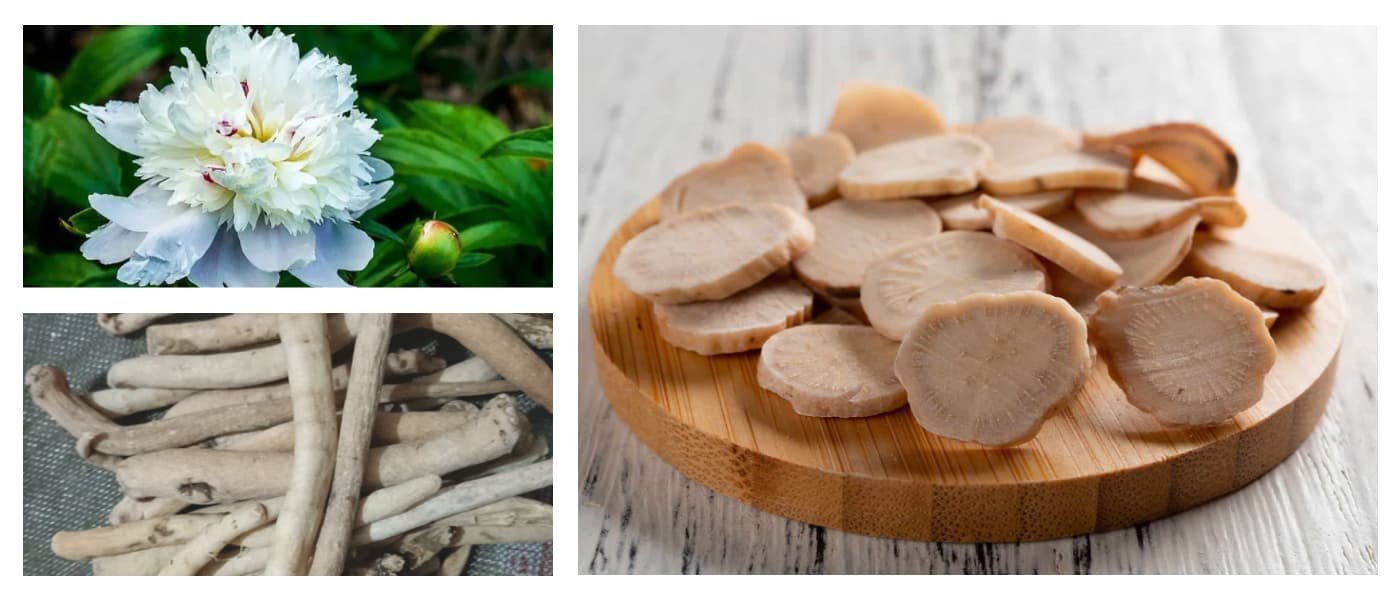
什么是白芍?
白芍,又名白芍,是牡丹科植物芍药的干燥根及炮制后的根。白芍在传统中药(TCM)中的应用历史悠久,尤其以维护女性健康而闻名,常用于缓解痛经和调经。白芍性微寒,味苦、酸,主入肝、脾经。其功效包括养血、柔肝、止痛、和中,因此有“调肝药”之称。
白牡丹根有什么好处?
传统用途
1.和阴卫,止痛:
它通常用于治疗自汗、盗汗以及腹部绞痛和月经不适等各种疼痛。
2.养血柔肝:
白芍有助于补血、维护肝功能,并缓解头晕、面色苍白、月经不调等症状。它还能舒缓情绪波动、烦躁和焦虑。
3.支持女性健康:
它对女性尤其有益,常与当归和川芎等草药结合使用,用于调节月经周期、缓解痛经以及治疗闭经或月经量少。
1. 白牡丹调节雌激素:
研究表明,白芍中的关键成分,例如芍药苷,能够影响下丘脑-垂体-卵巢(HPO)轴,促进雌激素分泌,帮助调节女性体内的激素平衡。白芍常用于治疗月经不调、多囊卵巢综合征(PCOS)和更年期综合征等疾病。
2.白牡丹根治疗抑郁和焦虑:
现代研究表明,白芍能够调节与情绪调节密切相关的神经递质,例如血清素 (5-HT) 和去甲肾上腺素。它还具有神经保护作用,使其成为一种天然温和的焦虑和抑郁治疗方案。
3.白牡丹根用于免疫调节:
白芍通过调节TNF-α和IL-6等细胞因子,并增强巨噬细胞活性来调节免疫系统。研究表明,它具有双向作用:既能增强低下的免疫力,又能抑制过度活跃的免疫反应,因此对系统性红斑狼疮和类风湿性关节炎等自身免疫性疾病具有潜在疗效。
4.白牡丹具有抗炎、镇痛作用:
白芍药中的芍药苷具有强效抗炎功效。它能抑制前列腺素和白三烯等炎症介质的释放,从而有助于减轻炎症。白芍药还通过中枢和外周机制发挥镇痛作用,对关节炎和痛经等症状有效。
5.白牡丹具有抗肿瘤潜力:
初步研究表明,白芍提取物可能通过诱导细胞凋亡、抑制血管生成和调节细胞周期来抑制多种癌细胞的生长和转移。尽管仍需更多临床证据,但其抗肿瘤潜力正引起越来越多研究人员的兴趣。
如何使用白牡丹
常见剂型: 白芍常用于煎剂、散剂或丸剂。在现代中医中,白芍也以提取物胶囊或片剂的形式存在。
常规用量:煎服,每日6至15克。浸泡约30分钟后慢火煮沸。具体剂量和剂型应由合格中医师根据个人需求确定。
注意事项和副作用
2.孕期注意事项:虽然一些孕期安全配方中含有白芍,但只能在专业人员的监督下使用。
3.可能的药物相互作用:本品可能会增强抗凝剂的作用。请务必告知医生您正在服用的所有药物和补充剂。
4.避免与某些草药或食物配伍:白芍不应与藜芦或黄芩同服,因为这些组合可能会抵消其功效或引起不良反应。日常生活中,应避免食用可能与其发生相互作用的有毒植物。
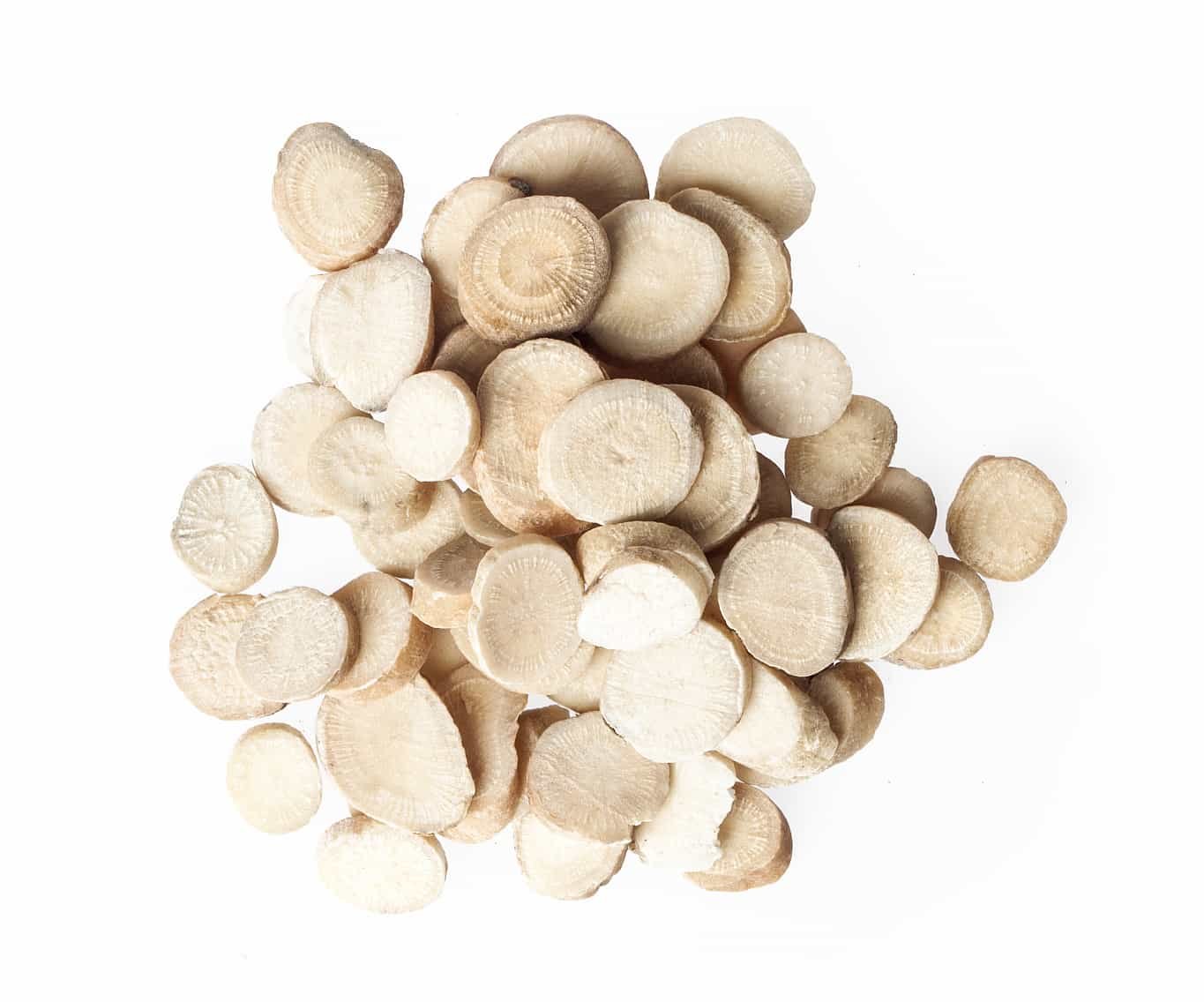
If you’re looking for a gentle yet effective herbal remedy to ease emotional imbalances, regulate menstruation, and nourish blood, White Peony Root is a valuable option. However, it should always be used under professional guidance for optimal results.
References on Paeonia lactiflora (White Peony Root)
Paeonia lactiflora (White Peony Root) Phytochemistry and Constituents
1. Ma W, Ren H, Meng X, Liu S, Du K, Fang S, et al. A review of the ethnopharmacology, phytochemistry, pharmacology, pharmacokinetics and quality control of Paeonia lactiflora Pall. J Ethnopharmacol. 2024;335:118616.
View Article
2. Li P, Shen J, Wang Z, Liu S, Liu Q, Li Y, et al. Genus Paeonia: a comprehensive review on traditional uses, phytochemistry, pharmacological activities, clinical application, and toxicology. J Ethnopharmacol. 2021;269:113708.
View Article
3. Zhao D-D, Jiang L-L, Li H-Y, Yan P-F, Zhang Y-L. Chemical components and pharmacological activities of terpene natural products from the genus Paeonia. Molecules. 2016;21(10):1362.
View Article
4. Tanaka T, Iino M, Kouno I. Paeoniflorins A–E: five new monoterpene glucosides from the fruits of Paeonia lactiflora. J Nat Prod. 2000;63(9):1363–1367.
View Article
5. Wang H-B, Gu W-F, Chu W-J, Zhang S, Tang X-C, Qin G-W. Monoterpene glucosides from Paeonia lactiflora. J Nat Prod. 2009;72(7):1321–1324.
View Article
6. Braca A, Kiem PV, Yen PH, Nhiem NX, Quang TH, Cuong NX, et al. New monoterpene glycosides from Paeonia lactiflora. Fitoterapia. 2008;79(2):117–120.
View Article
7. Kim SH, Lee MK, Lee KY, Sung SH, Kim JW, Kim YC. Chemical constituents isolated from Paeonia lactiflora roots and their neuroprotective activity against oxidative stress in vitro. J Enzyme Inhib Med Chem. 2009;24(5):1138–1140.
View Article
8. Li R, Li Y-C, Wu Y-Z, Wang L-Y, Qiu B-L, Zhang J-F, Lin S. [Chemical constituents from water-soluble extract of dry roots of Paeonia lactiflora]. China J Chin Mater Med. 2018;43(14):2956–2963. (In Chinese)
View Article
9. Li P, Zhang Z-M, Li T, Zhang Y-B, Sze SC, Wang G-C, et al. Monoterpene derivatives from the roots of Paeonia lactiflora and their anti-proliferative activity. Fitoterapia. 2014;98:124–129.
View Article
10. Liu W, Li D-D, Yang H-S, Chen Y-Y, Wei J-F, Kang W-Y, Guo X-C. Determination of oleanolic acid and paeoniflorin in Paeonia lactiflora by ultrasound-assisted ionic liquid RP-HPLC. China J Chin Mater Med. 2015;40(4):443–449. (In Chinese)
View Article
11. Zhou J-X, Braun MS, Wetterauer P, Wetterauer B, Wink M. Antioxidant, cytotoxic, and antimicrobial activities of Glycyrrhiza glabra L., Paeonia lactiflora Pall., and Eriobotrya japonica (Thunb.) Lindl. extracts. Medicines (Basel). 2019;6(2):43.
View Article
Paeonia lactiflora (White Peony Root) Pharmacology and Bioactivities
12. He D-Y, Dai S-M. Anti-inflammatory and immunomodulatory effects of Paeonia lactiflora Pall., a traditional Chinese herbal medicine. Front Pharmacol. 2011;2:10.
View Article
13. Zhang W, Dai S-M. Mechanisms involved in the therapeutic effects of Paeonia lactiflora Pallas in rheumatoid arthritis. Int Immunopharmacol. 2012;14(1):27–31.
View Article
14. Zhang L, Wei W. Anti-inflammatory and immunoregulatory effects of paeoniflorin and total glucosides of peony. Pharmacol Ther. 2020;207:107452.
View Article
15. Zhou Y-X, Gong X-H, Zhang H, Peng C. A review on the pharmacokinetics of paeoniflorin and its anti-inflammatory and immunomodulatory effects. Biomed Pharmacother. 2020;130:110505.
View Article
16. Li M, Zhu X, Zhang M, Yu J, Jin S, Hu X, Piao H. The analgesic effect of paeoniflorin: a focused review. Open Life Sci. 2024;19(1):20220905.
View Article
17. Li X, Sun C, Zhang J, Hu L, Yu Z, Zhang X, et al. Protective effects of paeoniflorin on cardiovascular diseases: a pharmacological and mechanistic overview. Front Pharmacol. 2023;14:1122969.
View Article
18. Jiang H, Li J, Wang L, Wang S, Nie X, Chen Y, et al. Total glucosides of peony: a review of its phytochemistry, role in autoimmune diseases, and mechanisms of action. J Ethnopharmacol. 2020;258:112913.
View Article
19. Wang Q-S, Gao T, Cui Y-L, Gao L-N, Jiang H-L. Comparative studies of paeoniflorin and albiflorin from Paeonia lactiflora on anti-inflammatory activities. Pharm Biol. 2014;52(9):1187–1191.
View Article
20. Zheng Y-Q, Wei W, Zhu L, Liu J-X. Effects and mechanisms of paeoniflorin, a bioactive glucoside from peony root, on adjuvant arthritis in rats. Inflamm Res. 2007;56(5):182–188.
View Article
21. Ji Y, Wang T, Wei Z-F, Lu G-X, Jiang S-D, Xia Y-F, Dai Y. Paeoniflorin, the main active constituent of Paeonia lactiflora roots, attenuates bleomycin-induced pulmonary fibrosis in mice by suppressing the synthesis of type I collagen. J Ethnopharmacol. 2013;149(3):825–832.
View Article
22. Wang J, Wan Y, Zheng N. Albiflorin ameliorates depressive-like behaviors in mice induced by chronic unpredictable mild stress. Curr Top Nutraceut Res. 2020;18(2):102–107.
View Article
23. Yang H-O, Ko W-K, Kim J-Y, Ro H-S. Paeoniflorin: an antihyperlipidemic agent from Paeonia lactiflora. Fitoterapia. 2004;75(1):45–49.
View Article
24. Fan Z, Liu J, Wang X, Yang S, Wang Q, Yan L, et al. Paeoniae Radix Rubra: a review of ethnopharmacology, phytochemistry, pharmacological activities, therapeutic mechanism for blood stasis syndrome, and quality control. Chem Biodivers. 2024;21(8):e202401119.
View Article
25. Sun Y, Liu T, Zhao X. Progress in the study of chemical structure and pharmacological effects of total peony glycosides isolated from Radix Paeoniae Rubra. Curr Issues Mol Biol. 2024;46(9):10065–10086.
View Article
26. Wang A, Zhao W, Yan K, Huang P, Zhang H, Ma X. Preclinical evidence of paeoniflorin effectiveness for the management of cerebral ischemia/reperfusion injury: a systematic review and meta-analysis. Front Pharmacol. 2022;13:827770.
View Article
27. Okubo T, Nagai F, Seto T, Satoh K, Ushiyama K, Kano I. Estrogenic and anti-estrogenic activities of herbal extracts used in traditional Chinese medicine. Cytotechnology. 1998;26(1):45–52.
View Article
28. Chen Y, Han M, Wang H, Gong B, Yu H, Zhang X. Paeoniflorin attenuates experimental colitis by inducing regulatory T cells and suppressing Th17 responses. Int Immunopharmacol. 2017;48:261–269.
View Article
29. Liu L, Xu D-M, Yang H, Zhang M, Yang X. Paeoniflorin inhibits HMGB1 signaling and attenuates synovial inflammation in collagen-induced arthritis. J Cell Mol Med. 2020;24(2):1815–1829.
View Article
30. Guan F, Lam W, Hu R, Kim YK, Han H, Cheng Y-C. Majority of Chinese medicine herb category “Qing Re Yao” have multiple mechanisms of anti-inflammatory activity. Sci Rep. 2018;8(1):7416.
View Article
Paeonia lactiflora (White Peony Root) Clinical and Applied Studies
31. Luo J, Jin D-E, Yang G-Y, Zhang Y-Z, Wang J-M, Kong W-P, et al. Total glucosides of paeony for rheumatoid arthritis: a systematic review of randomized controlled trials. Complement Ther Med. 2017;34:46–56.
View Article
32. Liu B, Meng X, Ma Y, Li H, Liu Y, Shi N, et al. Clinical safety of total glucosides of paeony adjuvant therapy for rheumatoid arthritis (used in traditional contexts): a systematic review and meta-analysis. BMC Complement Med Ther. 2021;21(1):102.
View Article
33. Huang Y, Wang H, Chen Z, Wang Y, Qin K, Huang Y, et al. Efficacy and safety of total glucosides of paeony combined with methotrexate and leflunomide for active rheumatoid arthritis: a meta-analysis. Drug Des Devel Ther. 2019;13:1969–1984.
View Article
34. Feng Z-T, Xu J, He G-C, Cai S-J, Li J, Mei Z-G. A systematic review and meta-analysis of the clinical efficacy and safety of total glucosides of peony combined with methotrexate in rheumatoid arthritis. Clin Rheumatol. 2018;37(1):35–42.
View Article
35. Chen X, Wang Z, Cao M, Li X. Total glucosides of Paeonia lactiflora for safely reducing disease activity in systemic lupus erythematosus: a systematic review and meta-analysis. Front Pharmacol. 2022;13:834947.
View Article
36. Sano Y, Takasu A. Effect of Shakuyaku-kanzo-to in patients with muscle cramps: a systematic literature review. J Gen Fam Med. 2020;21(6):236–241.
View Article
37. Zhu S, Liu Y, Yu J, Komatsu K, Li X, Kaneko S, et al. Genetic and chemical characterization of white and red peony root derived from Paeonia lactiflora. J Nat Med. 2015;69(2):239–246.
View Article
38. Chinese Pharmacopoeia Commission. Pharmacopoeia of the People’s Republic of China. Vol I. Beijing: China Medical Science Press; 2020. p. 135–136. (Monograph of Paeoniae Radix Alba)
View Article
39. Bensky D, Clavey S, Stöger E. Chinese Herbal Medicine: Materia Medica. 3rd ed. Seattle: Eastland Press; 2004. p. 358–362. (Monograph of White Peony Root)
View Article
40. Sato Y, Ohta K, Shiga R, Kuroda M, Yamada H, Uchida K. Orally administered Shakuyaku-kanzo-to significantly ameliorates muscle cramps in hemodialysis patients: a double-blind, placebo-controlled study. Am J Chin Med. 2003;31(3):331–341.
View Article
41. Zhou X, Chen Y, Zhao Y, Liu H, Yuan H. Total glucosides of peony as adjunctive therapy in primary Sjögren’s syndrome: a systematic review and meta-analysis. Evid Based Complement Alternat Med. 2019;2019:3635782.
View Article
Chinese Materia Medica (Zhong Hua Ben Cao): White Peony Root (Bai Shao)
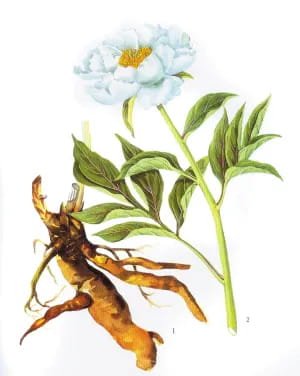
Alternative Names:White Peony Root (Bai Shaoyao), Golden Peony Root (Jin Shaoyao)
Historical Origin:
White Peony Root is a type of peony first recorded in the classic “Shennong’s Herbal Classic” (Shen Nong Ben Cao Jing). Tao Hongjing first distinguished between red and white varieties, noting: “The best grows in Baishan, Jiangshan, and Maoshan, which are white, large, and thick. Others are mostly red, smaller, and mildly beneficial.” The “Kai Bao Ben Cao” states: “There are two varieties; the red type promotes urination and gas release, while the white variety alleviates pain and disperses blood. Their flowers also come in red and white colors.” According to “Ben Cao Tu Jing”: “There are two types, golden peony root and woody peony root. The golden variety is medicinal, white, and rich in fat, while the woody one is purple and lean with many veins.” It further states: “Now found everywhere, best in Huainan region. Red buds sprout in spring forming clusters, stems branch into three parts with five leaves, similar to peonies but narrower and longer, 30-60 cm tall, flowering in summer.”
Botanical Source:
Derived from the dried roots of cultivated herbaceous plants Paeonia lactiflora Pall. and Paeonia lactiflora Pall. var. trichocarpa (Bunge) Stern.
Latin Botanical Names:
- Paeonia lactiflora Pall. [P. albiflora Pall.]
- Paeonia lactiflora Pall. var. trichocarpa (Bunge) Stern [P. albiflora Pall. var. trichocarpa Bunge; P. yui Fang]
Harvest and Storage:
- Grows naturally in grassy hillsides and forests.
- Found in mountainous shrubs.
Geographical Distribution:
- Northeast China, North China, Shaanxi, and Gansu; widely cultivated across various towns and villages.
- Northeast China, Inner Mongolia, Hebei, Shanxi; also widely cultivated.
- Paeonia lactiflora: Perennial herb, 40-70 cm tall, hairless, thick spindle or cylindrical-shaped dark-brown roots. Erect branching stems, basal membranous scales. Alternately arranged leaves, compound with narrow oval or elliptical leaflets, 7.5-12 cm long, 2-4 cm wide, slightly leathery, smooth above with sparse hairs beneath along veins. Flowers bisexual, white petals often marked with deep purple or pink bases, numerous stamens, yellow anthers. Fruits are oval follicles. Flowers May-June, fruits June-August.
- Paeonia lactiflora var. trichocarpa: Differs mainly in densely hairy carpels and young fruits; mature follicles sparsely hairy.
Propagation methods include seeds and root division. Sow seeds late September in trenches 3 cm deep, covered with 6-10 cm soil. Roots can be divided into sections with 1-2 buds each, planted 60-90 cm apart. Around 30,000 plants per hectare are recommended. Fertilize moderately to enhance yield.
Field Management:
Loosen soil regularly, especially after rains, weed 4-6 times annually. Cut back foliage before winter, mound soil around roots for frost protection. Apply phosphorus and potassium fertilizers thrice yearly, remove flower buds promptly unless for seed production.
Disease and Pest Management:
Treat diseases like brown spot, damping-off, root rot, grey mold, and rust using fungicides like Carbendazim or Zinc Mancozeb, or remove infected plants entirely. Pests include spider mites, aphids, grubs, and cutworms.
Medicinal Identification:
Roots cylindrical, uniform in thickness, straight, 5-20 cm long, 1-2.5 cm diameter. Bo White Peony (Bo Baishao) surface powdery white or off-white, smooth; Hang White Peony (Hang Baishao) brownish, rough with visible wrinkles. Firm, heavy texture, difficult to break, greyish-white cross-section with faint radiating lines, slight scent, taste mildly bitter and sour. Highest quality roots are thick, straight, smooth, firm, and powdery white internally without cracks.
Microscopic Characteristics:
Root cross-sections and powdered form contain calcium oxalate crystals (10-39μm), fiber tracheids, reticulate or scalariform bordered pitted vessels (30-80μm diameter), and starch granules often gelatinized.
Chemical Identification:
Refer to thin-layer chromatography standards under “Chi Shao” (Red Peony Root).
Commercial Grades:
Bo White Peony: Four grades based on length and diameter. Grade 1 is longest (≥8cm), thickest (≥1.7cm), free from impurities or defects.Hang White Peony: Seven grades based on similar criteria, with grade 1 being the thickest (≥2.2cm diameter). Other regions typically classify into four grades.
Toxicity:
Acute Toxicity:Intraperitoneal injection of Paeonia lactiflora methanol extract at 6 g/kg induced reduced spontaneous movements, piloerection, diarrhea, respiratory depression, with 50% mortality in rats and complete mortality in mice within 2 days. No abnormalities occurred with oral administration. Paeoniflorin intravenous LD50 in mice is 3.53 g/kg, intraperitoneal LD50 is 9.53 g/kg, with no mortality orally. Total glucosides from White Peony (Bai Shao) have intraperitoneal LD50 values of 125 mg/kg (mice) and 301 mg/kg (rats). Another study reported intravenous and intraperitoneal LD50 in mice as 159 mg/kg and 230 mg/kg, respectively, and oral LD50 >2500 mg/kg with no apparent toxicity or death.
Subacute Toxicity:Rats orally administered 1.5 g/kg and 3.0 g/kg daily for 21 days showed increased urine protein at lower doses, significant weight loss, decreased red blood cell count, hemoglobin, and hematocrit at higher doses, with increased mean corpuscular volume and red cell distribution width suggesting macrocytic anemia. Both dosages caused dose-dependent spleen enlargement, dilated and congested spleen sinusoids, and significantly increased lung weight.
Chronic Toxicity:Daily oral administration of total glucosides from White Peony (Bai Shao) at 50 mg/kg, 1000 mg/kg, and 2000 mg/kg in rats for 90 days showed increased platelet counts but no other significant abnormalities.
Mutagenicity:Negative mutagenicity results in Salmonella typhimurium Ames test, Chinese hamster lung cell chromosome aberration test, and mouse bone marrow micronucleus test.
Chemical Composition:Root contains paeoniflorin, oxy-paeoniflorin, benzoylpaeoniflorin, albiflorin, paeoniflorigenone, galloylpaeoniflorin, β-pinen-10-yl-β-vicianoside, lacioflorin, paeoni-lactone A, B, C, β-sitosterol, daucosterol. Tannins include 1,2,3,6-tetra-O-galloyl-β-D-glucose, 1,2,3,4,6-penta-O-galloyl-β-D-glucose, corresponding hexa- and hepta-O-galloyl glucoses, catechin, and volatile oils mainly containing benzoic acid, paeonol, and other phenolic and alcoholic compounds (totaling 33 identified).
Pharmacological Actions:
- Central Nervous System Depression:
Significant analgesic effects noted; total glucosides from White Peony inhibit pain in mice (dose-dependent) and rats. Also enhances sedative effects of cyclohexylbarbitone sodium and pentobarbital sodium.
- Antispasmodic Effects:
Reduces smooth muscle tension, counteracting spasms induced by barium chloride, potentially via inhibition of parasympathetic neurotransmitter release.
- Anti-inflammatory and Anti-ulcer Effects:
Weak anti-inflammatory action on various edema types. Also exhibits preventive effects on stress-induced gastric ulcers.
- Immune Modulation:
Enhances macrophage phagocytic activity, recovers immune suppression caused by cyclophosphamide, and modulates T-cell mediated immunity.
- Cardiovascular Effects and Hypoxia Resistance:
Vasodilation, improved blood flow, and enhanced survival in hypoxic conditions demonstrated.
- Effects on Hematological System:
Reduces serum urea nitrogen, ameliorates anemia from acute blood loss, and inhibits platelet aggregation.
- Antimicrobial Activity:
Broad-spectrum antimicrobial efficacy against bacteria, fungi, and certain viruses.
- Hepatoprotective and Detoxification Effects:
Reduces liver damage and enzymatic elevations from hepatotoxins like aflatoxin B1 and T-2 toxin.
- Anti-mutagenic and Anti-tumor Effects:
Inhibits carcinogen-induced mutagenicity, enhances anti-tumor drug efficacy, and reduces chemotherapy-induced leukopenia.
- Other Effects:
Neuromuscular blockade, inhibition of aldose reductase (relevant in diabetic neuropathy), antagonism of pancreatic enzyme secretion stimulated by cholecystokinin, and inhibition of various receptor-mediated biological pathways including histamine release from mast cells.
Processing Methods:
- White Peony Root (Bai Shao):
Current practice: Select raw herb, remove impurities, sort by size, soak until partially hydrated, steam thoroughly until fully softened, slice thinly, and dry.
- Dry-fried White Peony Root (Chao Bai Shao):
Current practice: Heat White Peony Root slices gently until the surface turns slightly yellow, remove, and cool. This method moderates the medicinal nature, calms the liver, harmonizes the spleen, and stops diarrhea.
- Wine-fried White Peony Root (Jiu Bai Shao):
Current practice: Spray slices evenly with yellow rice wine, slightly moisten, gently dry-fry until dry, remove and cool. Ratio: 100kg slices to 10kg wine. Used to regulate menstruation and relieve abdominal pain caused by internal cold.
- Vinegar-fried White Peony Root (Cu Bai Shao):
Current practice: Mix slices with rice vinegar, slightly moisten, gently dry-fry until dry, remove and cool. Ratio: 100kg slices to 15kg vinegar. Used to consolidate blood and stop bleeding.
- Earth-fried White Peony Root (Tu Chao Bai Shao):
Current practice: Heat fine stove earth (Fu Long Gan) in a pan, add White Peony Root slices, dry-fry until lightly coated with earth, turning slightly yellowish-brown, remove, sieve off excess earth, and cool. Ratio: 100kg slices to 20kg stove earth.
- Charred White Peony Root (Bai Shao Tan):
Additional methods include baked, salt-fried, and bran-fried White Peony Root.
Description of Prepared Slices:
Charred White Peony Root: Surface blackened due to charring.
Identification:
- Boil 0.5g powder in 10ml water, filter; add one drop of ferric chloride reagent, forming a blue-black precipitate (tests for tannins).
- Thin-layer chromatography (TLC): Dissolve 0.5g powder in ethanol, prepare a standard paeoniflorin solution (2mg/ml), apply 4μl each solution onto silica gel G plate, develop with chloroform-ethyl acetate-methanol-formic acid (40:5:10:0.2), dry, spray with 5% vanillin sulfuric acid solution, heat until spots appear. Sample solution shows the same blue-purple spot as the standard solution.
Quality Indicator:Must contain no less than 2.0% paeoniflorin (C23H28O11).
Channel Tropism:
Liver and Spleen
Nature and Flavor:
Bitter, sour, slightly cold
Cautions:
Not suitable for use alone in deficiency-cold conditions; incompatible with Veratrum (Li Lu).
Annotations to the Classic of Materia Medica (Ben Cao Jing Ji Zhu): “Conflicts with Dendrobium and Mirabilite; avoid combination with Saltpetre, Turtle Shell, Small Thistle; incompatible with Veratrum.”
Extended Meanings of Materia Medica (Ben Cao Yan Yi): “Contraindicated in individuals with blood deficiency and cold constitution. The ancients warned to reduce use of White Peony Root to avoid internal cold—advice that should not be ignored.”
Commentary on the Classic of Materia Medica (Ben Cao Jing Shu): “White Peony Root is sour and cold; contraindicated for abdominal pain, diarrhea, or sensations of cold in the gastrointestinal tract caused by internal cold.”
Correction to the Materia Medica (Ben Cao Zheng Yi): “Should not be used in cases of cold spleen with bloating and difficulty in digestion.”
Interpretation of Medicinal Substances (Yao Pin Hua Yi): “Contraindicated in cases of measles.”
Materia Medica with Therapeutic Combinations (De Pei Ben Cao): “Contraindicated for spleen deficiency with cold, pure blood diarrhea, and postpartum patients.”
Functions and Indications:
Nourishes the blood, harmonizes the nutritive Qi, relieves spasms and pain, consolidates Yin, and calms the liver. Commonly used for irregular menstruation, menstrual cramps, excessive uterine bleeding, spontaneous and night sweating, pain in the hypochondriac and abdominal regions, spasms in the limbs, headache, and dizziness.
Dosage:
Internal use: decoction 5–12g; for stronger effect, up to 15–30g.
Historical References:
Originally known as Shaoyao, or “Spoon Medicine,” as noted in the Book of Songs – Zheng Feng (Shi Jing·Zheng Feng, 《毛诗·郑风》): “Given as Shaoyao.” Li Shizhen wrote in Compendium of Materia Medica (Ben Cao Gang Mu, 《本草纲目》): “Shaoyao symbolizes elegance and beauty,” describing the flower’s graceful form. Zhuangzi – Free and Easy Wandering (Zhuangzi·Xiao Yao You, 《庄子·逍遥游》) says: “Gentle like a maiden.” Han Shi Wai Zhuan (Han Shi, 《韩诗》) mentions: “Shaoyao, a plant of parting.” Dong Zhongshu explained: “Shaoyao is also called Ke Li, and is thus given as a token of farewell.”
Clinical Applications:Fu Kang Ning Tablets:
(Source: Ministry of Health, Drug Standards – Chinese Herbal Formulations, Vol. 2, 1989)
Commentaries from Classical Texts:
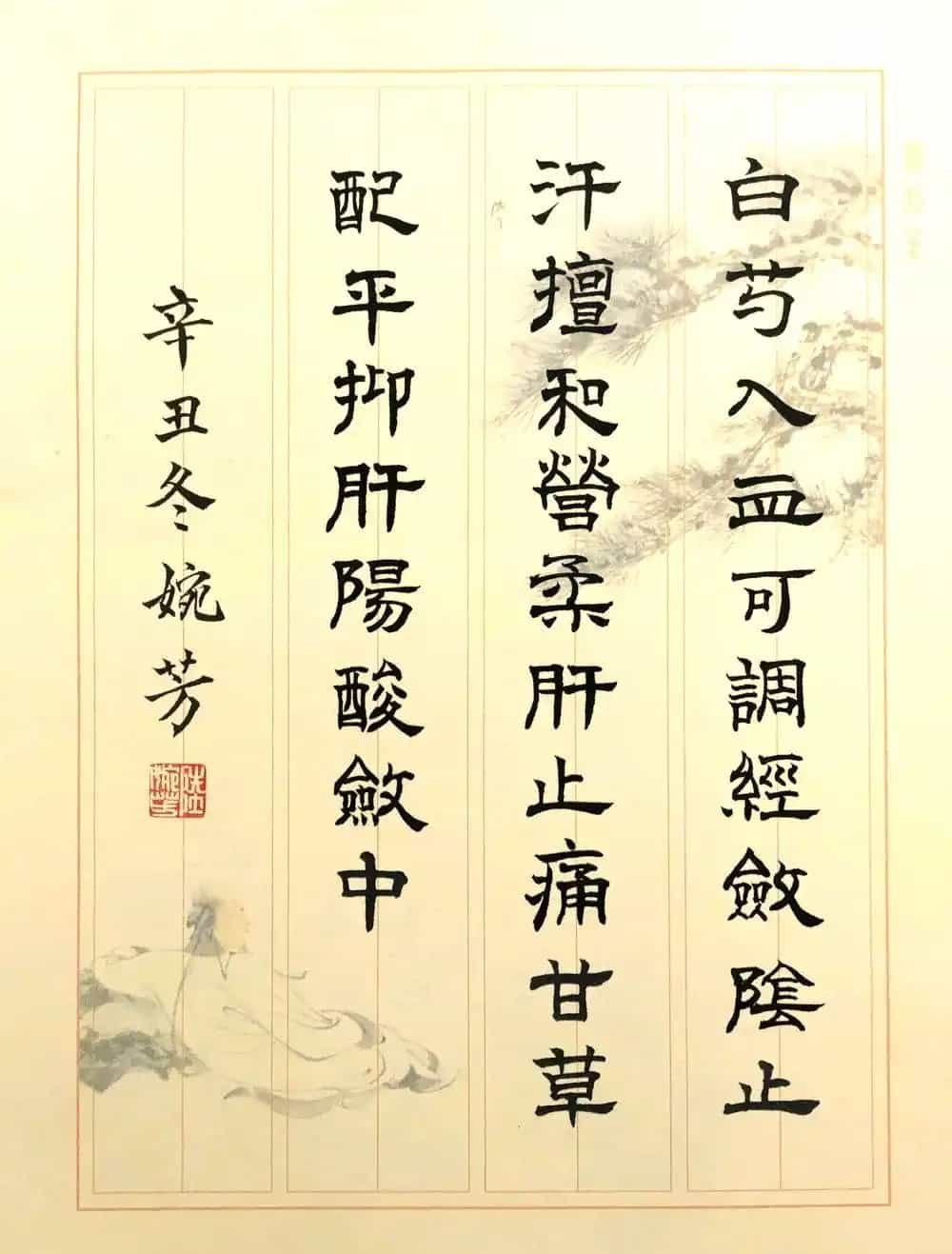
1.Illustrated Classic of Materia Medica (Ben Cao Tu Jing):
“Shaoyao roots come in two colors: red and white. Cui Bao in Notes on the Past and Present (Gu Jin Zhu, 《古今注》) stated there are two types: Herbaceous Peony (Cao Shaoyao) and Tree Peony (Mu Shaoyao). The tree type has larger, darker flowers and is commonly mistaken for the Moutan (Paeonia suffruticosa), but it is not.”
“The immortals of old sometimes consumed it alone. According to An Qi Sheng’s elixir method: there are two types—Golden Peony (Jin Shaoyao) and Tree Peony (Mu Shaoyao). For medicinal use, choose Golden Peony—its roots are white and plump with more substance, while Tree Peony is purplish, slender, and veinous. Be careful to distinguish them. For internal use, clean and scrape off the skin, boil in running water a hundred times, dry in the shade, then steam in a wooden steamer covered with clean yellow clay for a full day and night before final drying.”
2.Alternative Sayings on Materia Medica (Ben Cao Bie Shuo):
“According to Shennong’s Classic of Materia Medica, Peony grows in hills and valleys, but what we use today is mostly cultivated. For larger flowers and leaves, farmers enrich the soil; roots are harvested in August or September, sliced and dried for sale. The best White Peony Root comes from Zhenyang in Huainan, but many traders only judge by size and ignore fragrance or potency—thus its effectiveness is poor. It’s best to follow Shennong’s Classic and select wild ones from hills and valleys.”
3.Extended Meanings of Materia Medica (Ben Cao Yan Yi):
“Only the root is used. Prefer single-flowered plants with red petals from mountainous regions—more leaves often mean weaker roots. Though the root is typically red and astringent, the white, thicker ones are better. For people with blood deficiency and internal cold, it is contraindicated.”
From Commentary on the Classic of Materia Medica (Ben Cao Jing Shu):
“White Peony Root harmonizes the middle burner, soothes the liver, and supports the spleen. When spleen Qi is deficient, there’s bloating; when in excess, the bloating resolves itself. Harmonizing the middle reduces epigastric hardness; draining the liver relieves hypochondriac pain. Frequent belching reflects spleen dysfunction—when spleen improves, the belching stops. Liver fire flaring causes lung distension, reverse flow, and cough. Sour-cold Peony Root drains liver fire and supports the spleen, thus calming the lungs. It cools and nourishes the blood to stop nosebleeds. Spleen deficiency causes dry eyes, which Peony Root alleviates by nourishing blood. Liver harmony and abundant Yin resolve conditions like alternating chills and fever (Yang Wei disorder), abdominal fullness and pain (Dai Mai disorder), and more.”
From Materia Medica Rooted in Original Principles (Ben Cao Chong Yuan), Zhang Yinan:
“Peony is bitter and neutral. Wind-wood pathogens disturb the Earth (spleen), obstructing its meridians and causing abdominal pain. Peony clears meridians, allowing such pain to resolve. The Heart governs blood, the Liver stores it. Peony, with Wood energy, treats the Liver; with Fire energy, treats the Heart—thus resolving blood stasis and dissolving masses. It helps treat hernia, lower abdominal masses, urinary difficulty, and supports Qi in the blood. Promoting Qi helps blood circulation.”
4.On the Sour and Astringent Nature of Peony Root:
Commentary on Treatise on Cold Damage (Zhu Jie Shang Han Lun), Cheng Wuji:
“The sour taste of Peony Root helps astringe fluids and strengthen the body’s nourishing aspect. Sour both astringes and disperses—it draws in Yin while expelling pathogenic Qi.”
Compendium of Materia Medica (Ben Cao Gang Mu), citing Li Dongyuan:
“Some ask, if sourness astringes, why does Peony Root promote urination? Because it nourishes Yin and moistens, causing spontaneous urination—not due to diuretic action. As for its middle-tonifying function—it soothes the liver and regulates blood, hence its use in Siwu Tang. Its astringency helps stop fluid loss and strengthen the Spleen and Liver. White Peony belongs to Metal (West) and supplements; Red Peony to Fire (South) and purges.”
Interpretation of Medicinal Substances (Yao Pin Hua Yi), Jia Suoxue:
“White Peony is slightly bitter and mildly sour. The sour enters the Liver, and though the Liver prefers spreading, astringency helps restrain excess. It thus both supplements and purges—adjusting menstruation, treating liver disorders in men and women, regulating blood and Yin. Though not originally a spleen herb, stir-frying moderates its cold nature. It helps relieve diarrhea, abdominal pain, and damp-heat conditions. Its sour nature helps restrain Liver fire and support Spleen Qi.”
5.Correct Meaning of Materia Medica (Ben Cao Zheng Yi), Zhang Shanlei:
“Some believe Peony Root conquers Liver Wood to support Spleen Earth, thus relieving abdominal pain. But more importantly, the Liver’s harsh nature must be softened with nourishing Yin. Overuse of warm, pungent Qi-moving herbs harms Yin, leading to worsening of Liver-Spleen disharmony. Zhang Zhongjing used Peony to nourish Liver and Spleen Yin, softening rigid Liver Qi rather than attacking it. Thus, Peony Root is not a Liver-attacking herb, but a Liver-softening one.”
6.On Abdominal Pain:
Compendium of Materia Medica (Ben Cao Gang Mu), Zhu Danxi:
“Peony Root clears Spleen fire. Being sour and cold, it must be wine-fried in winter. Abdominal pain is often due to blood stasis, so it also requires wine-frying. It only treats blood-deficiency-type pain, not others, as it lacks warming or dispersing qualities.”
Essentials of Materia Medica (Ben Cao Bei Yao), Yu Chuan:
“White Peony doesn’t only treat blood deficiency; it also moves Qi. In ancient prescriptions, it is paired with Licorice Root for abdominal pain. Pain arises when Ying Qi (nutritive Qi) rebels under the skin. Peony regulates Ying Qi; Licorice harmonizes. Pain also stems from Liver overacting on the Spleen—Peony can restrain the Liver.”
7.On Peony Root Not Being a Tonifying Herb:
Reading the Classic of Materia Medica (Ben Cao Jing Du)Chen Xiuyuan:
“Peony Root descends and purges through its bitter flavor. It’s not a tonic. It relieves pain and urinary difficulty caused by Qi stagnation by dispersing it. For blood stasis diseases, it promotes blood circulation through its bitterness.”
8.On Peony Root Postpartum Usage:
Compendium of Materia Medica (Ben Cao Gang Mu), Zhu Danxi:
“Postpartum women should avoid Peony Root due to its sour and cold nature that suppresses vital energy. If necessary, it must be wine-fried.”
Compendium of Materia Medica (Ben Cao Gang Mu), Li Shizhen:
“Postpartum Liver blood is deficient—further purging is inappropriate.”
Correct Meaning of Materia Medica (Ben Cao Zheng Yi), Zhang Jingyue:
“Peony is slightly cold—not extremely so. To say its white color (Metal) restrains Liver Wood (Wood) and is thus harmful after childbirth is unreasonable. Formulas like Shaoyao Decoction are classic postpartum prescriptions. It should be used with care, not strictly forbidden.”
Correct Meaning of Materia Medica (Ben Cao Zheng Yi), Zhang Shanlei:
“Zhu Danxi’s claim that Peony should be avoided postpartum due to its cold-sour nature is too sweeping. Postpartum conditions vary. Peony is only contraindicated for cold-deficiency types. In cases of heat or excess, it is appropriate. Banning it entirely is not reasonable.”
9.On the Differences Between White and Red Peony Root:
Kai Bao Materia Medica (Kai Bao Ben Cao), Liu Han:
“There are two types—Red Peony promotes urination and Qi movement; White Peony relieves pain and disperses blood.”
Commentary on Treatise on Cold Damage (Zhu Jie Shang Han Lun), Cheng Wuji:
“White Peony nourishes; Red Peony purges. White astringes; Red disperses.”
Compendium of Materia Medica (Ben Cao Gang Mu), Li Shizhen:
“White Peony strengthens the Spleen and restrains overactive Liver. Red Peony expels pathogenic factors and invigorates blood. Earlier claims that Red Peony tonifies Qi and White Peony treats blood are inaccurate.”
Materia Medica (Ben Cao), Zhang Jingyue:
“White Peony is mainly nourishing; Red Peony is mainly purgative. White calms restlessness during pregnancy; Red promotes menstruation and invigorates blood.”
Cui Jin Qiu’s Commentary on Materia Medica (Cui Jin Qiu Ben Cao Shu Lu), Jiang Rong:
“Use White Peony when Yin is deficient and Yang hyperactive—to restore balance by nourishing Yin. Use Red Peony when Yin is excessive and Yang constrained—to disperse stagnation.”
Correct Meaning of Materia Medica (Ben Cao Zheng Yi), Zhang Shanlei:
《神农本草经》虽无红白之分,但其主治有别。白牡丹养血平肝脾;赤牡丹活血化瘀,解毒散结。
本页面提供的有关传统中草药的信息仅供教育和参考之用,不作为医疗建议、诊断或治疗。
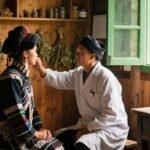


Leave a Reply